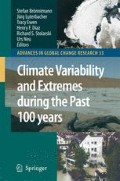Abstract
Satellite-borne microwave sounding instruments have been making measurements of the temperature of the Earth’s atmosphere for several decades. In order to construct a single atmospheric temperature data set from these measurements, data from a number of satellites must be combined, since each satellite operated only during a small part of the longer time period. If the combined data set is to be of sufficient quality to evaluate changes on the decadal or longer time scales, a number of calibration issues and time-varying biases must be addressed, and their effects removed from the data to the extent possible. Other sources of atmospheric temperature data, such as in situ measurements made by radiosondes and the output of the various reanalysis efforts, have not been demonstrated to be of high-enough quality to validate the satellite data. Because of this, satellite data is typically intercalibrated using a detailed analysis of data from periods of simultaneous operation by two or more satellites. When this type of calibration is used, long periods of simultaneous observation are needed to reduce uncertainties in the calibration procedure.
Access this chapter
Tax calculation will be finalised at checkout
Purchases are for personal use only
Preview
Unable to display preview. Download preview PDF.
References
Christy, J. R., R. W. Spencer, and W. D. Braswell, 2000: MSU tropospheric temperatures: dataset construction and radiosonde comparisons. J. Atmos. Ocean Tech., 17, 1153–1170.
Christy, J. R., R. W. Spencer, W. B. Norris, W. D. Braswell, and D. E. Parker, 2003: Error estimates of version 5.0 of MSU-AMSU bulk atmospheric temperatures. J. Atmos. Ocean Tech., 20, 613–629.
Fu, Q. and C. M. Johanson 2005: Satellite-derived vertical dependence of tropospheric temperature trends. Geophys. Res. Lett., 32, L10703.
Fu, Q., C. M. Johanson, S. G. Warren, and D. J. Seidel, 2004: Contribution of stratospheric cooling to satellite-inferred tropospheric temperature trends. Nature, 429, 55–58.
Grody, N. C., K. Y. Vinnikov, M. D. Goldberg, J. T. Sullivan, and J. D. Tarpley, 2004: Calibration of multi-satellite observations for climatic studies: Microwave Sounding Unit (MSU). J. Geophys. Res., 109, D24104, doi:10.1029/2004JD005079.
Lanzante, J., S. Klein, and D. Seidel2003: Temporal homogenization of monthly radiosonde temperature data. Part I: methodology. J. Climate, 16, 224–240.
Lanzante, J. R., T. C. Peterson, F. J. Wentz, and K. Y. Vinnikov, 2006: What do observations indicate about the change in temperatures in the atmosphere and at the surface since the advent of measuring temperatures vertically. In: Temperature Trends in the Lower Atmosphere: Steps for Understanding and Reconciling Differences, T. R. Karl, S. J. Hassol, C. D. Miller, and W. L. Murray, eds., A Report by the Climate Change Science Program and the Subcommittee on Global Change Research, Washington, DC, 47–70.
Mears, C. A., M. Schabel, F. J. Wentz, B. D. Santer, and B. Govindasamy, 2002: Correcting the MSU middle tropospheric temperature for diurnal drifts. Proceedings of the International Geophysics and Remote Sensing Symposium III, 1839–1841.
Mears, C. A., M. C. Schabel, and F. J. Wentz, 2003: A reanalysis of the MSU channel 2 tropospheric temperature record. J. Climate, 16, 3650–3664.
Mears, C. A., C. E. Forest, R. W. Spencer, R. S. Vose, and R. W. Reynolds, 2006: What is our understanding of the contribution made by observational or methodological uncertainties to the previously reported vertical differences in temperature trends. In: Temperature Trends in the Lower Atmosphere: Steps for Understanding and Reconciling Differences. T. R. Karl, S. J. Hassol, C. D. Miller, and W. L. Murray, eds., A Report by the Climate Change Science Program and the Subcommittee on Global Change Research, Washington, DC, 71–88.
Spencer, R. W. and J. R. Christy, 1992: Precision and radiosonde validation of satellite gridpoint temperature anomalies. Part II: a tropospheric retrieval and trends during 1979–1990. J. Climate, 5, 858–866.
Thorne, P. W., D. E. Parker, J. R. Christy, and C. A. Mears, 2005: Causes of differences in observed climate trends. Bull. Am. Meteorol. Soc., 86, 1437–1442.
Thorne, P. W., D. E. Parker, S. F. B. Tett, P. D. Jones, M. McCarthy, H. Coleman, and P. Brohan, 2005: Revisiting radiosonde upper-air temperatures from 1958 to 2002. J. Geophys. Res., 110, D18105.
Vinnikov, K. Y., N. C. Grody, A. Robock, R. J. Stouffer, P. D. Jones, and M. D. Goldberg, 2005: Temperature trends at the surface and in the troposphere. J. Geophys. Res., 111, D03106.
Wentz, F. J. and M. Schabel, 1998: Effects of satellite orbital decay on MSU lower tropospheric temperature trends. Nature, 394, 661–664.
Author information
Authors and Affiliations
Editor information
Editors and Affiliations
Rights and permissions
Copyright information
© 2008 Springer Science + Business Media B.V
About this chapter
Cite this chapter
Mears, C. (2008). Constructing Climate Quality Atmospheric Temperatures from Satellite Microwave Measurements. In: Brönnimann, S., Luterbacher, J., Ewen, T., Diaz, H., Stolarski, R., Neu, U. (eds) Climate Variability and Extremes during the Past 100 Years. Advances in Global Change Research, vol 33. Springer, Dordrecht. https://doi.org/10.1007/978-1-4020-6766-2_7
Download citation
DOI: https://doi.org/10.1007/978-1-4020-6766-2_7
Publisher Name: Springer, Dordrecht
Print ISBN: 978-1-4020-6765-5
Online ISBN: 978-1-4020-6766-2
eBook Packages: Earth and Environmental ScienceEarth and Environmental Science (R0)

